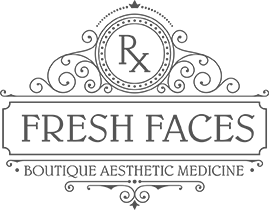Fresh Faces Rx Real Acne Solutions
Whether you have an occasional pimple or chronic, cystic breakouts, acne affects the way you feel about yourself. Eighty percent of us suffer from acne at some point, but that doesn’t make it any easier or less disfiguring. The purpose of this blog post is to cut to the chase and let you know what the main what the treatment options are.

Acne vulgaris is thought to be caused by 5 main factors:
1.Clogged pores
The hair follicle and accompanying sebaceous gland gets plugged by dead skin, overgrowth of skin cells, and inflammation.
2.Excess sebum (oil) production
Sebum is a light yellow, oily substance that is secreted by the sebaceous glands that help keep the skin and hair moisturized.
3.BacteriaCutibacterium acnes (formerly Propionibacterium acnes)
Elevated production of sebum by hyperactive sebaceous glands or blockage of the follicle can cause C. acnes bacteria to grow and multiply. The cellular damage, metabolic byproducts and bacterial debris produced by the rapid growth of C. acnes in follicles can trigger inflammation. The damage caused by C. acnes make the affected tissue more susceptible to colonization by opportunistic bacteria, such as Staphylococcus aureus.
4.Inflammation
Acne vulgaris appears to be a primary inflammatory disease, with histological, immunological, and clinical evidence suggesting that inflammation occurs at all stages of acne lesion development and even occurs when C. acnes is not present.
5.Genetics, hormones, and medications
Are likely contribute to the development and severity of acne as well.
Therapy is therefore aimed at reducing inflammation, eliminating the bacteria, and opening up the pores. Pretty simple right? Well, I’ll try to keep it that way. Current consensus recommends a combination of topical retinoid and antimicrobial therapy as first-line therapy for almost all patients with acne. We strongly recommend combination therapy, monotherapy has not been proven to be as effective.
Addressing the main causes:
1. Clogged pores
The pores are clogged by sebum, dead skin cells, and inflammation. We recommend treatments with mechanical exfoliation (microdermabrasion), chemical exfoliation (chemical peels, glycolic acid, salicylic acid), and acne focused facials and extractions. For your at home regimen we recommend ZO’s Acne kit: Offects® Exfoliating Cleanser, Offects® Exfoliating Polish, Offects® TE-Pads Acne Pore Treatment, Offects® TE-Pads Acne Pore Treatment Solution, and Offects® Sulfur Masque.
To Order Any of the ZO Products listed above, click here and enter the code ZOeIhux8
2. Bacteria (Cutibacterium acnes (formerly Propionibacterium acnes)
In this day and age we need to be concerned about antibiotic resistance, we are not big proponents of systemic antibiotics unless all else fails. When a topical or systemic antibiotic is used, it should be used in conjunction with benzoyl peroxide to reduce the emergence of resistance. Benzoyl peroxide products are also effective against C acnes and bacterial resistance to benzoyl peroxide has not been reported. In terms of topical antibiotics erythromycin and clindamycin are both effective against C acnes. Looking for a more natural approach? There are several essential oils that have antibacterial effects; we prefer maleleuca (tea tree oil), oregano oil, and juniper berry oil. The way to use essential oils for acne is to apply 2 drops topically to the area of concern. These oils are safe for neat or direct application, but they can also be combined with a carrier oil like coconut oil. Enroll to get DoTerra essential oils through Fresh Faces RX here. Learn more about the benefits of essential oils here.

3.Inflammation
Topical retinoids break down the comedones and reduce inflammation. They normalize follicular growth and keratinization. Topical retinoids can acutally reduce the total number of lesions. Consensus statements recommend topical retinoids as first-line therapy and continued as maintenance therapy. Inflammation can occur in the absence of bacteria, but when bacteria are present the byproducts are inflammatory, so again, antibacterials help with inflammation as well.
There is also a growing body of evidence for laser treatment of acne, not as stand alone therapy but in combination with topical treatments mentioned above. Preliminary studies have shown improvement in acne, and even potential long-lasting effects, we prefer the 1064-nm Nd:YAG laser (Aerolase Lightpod Neo).

Laser treatments are not a one-and-done. Several studies have shown that multiple treatments deliver significantly better results than a single treatment. Researchers continually find that patients see the best results weeks after the last treatment, you need to be patient. Results from lasers require maintenance, we recommend follow up every 3-6 months. Redness and swelling are common after treatment with many lasers treatments.
While all of these treatments are promising, nothing replaces a good skincare regimen at home. We are also quite curious about the growing body of evidence linking nutrition to acne, there may be more to worry about with milk than with French fries.
We also wanted to include the latest guidelines, for questions related to isotretinoin and oral contraceptives this is helpful.
Guidelines Summary
In 2016, the American Academy of Dermatology (AAD) issued new evidence-based guidelines for treatment of both adolescents and adults. Recommended treatments include topical therapy, antibiotics, isotretinoin, and oral contraceptives. [29] The key recommendations include the following:
Benzoyl peroxide or combinations with erythromycin or clindamycin as monotherapy for mild acne; benzoyl peroxide with a topical retinoid or systemic antibiotic therapy for moderate-to-severe acne
Topical antibiotics (eg, erythromycin, clindamycin) are not recommended as monotherapy because of the risk of bacterial resistance
Topical retinoids as monotherapy in primarily comedonal acne, or in combination with topical or oral antimicrobials for mixed or primarily inflammatory acne
Topical adapalene, tretinoin, and benzoyl peroxide can be safely used to treat acne in preadolescent children
Topical dapsone 5% gel for inflammatory acne, particularly in adult females
Systemic antibiotics are recommended for moderate and severe acne and forms of inflammatory acne that are resistant to topical treatments; doxycycline and minocycline are both more effective than tetracycline
Topical therapy with benzoyl peroxide or a retinoid should be used with systemic antibiotics and for maintenance after completion of systemic antibiotic therapy
Monotherapy with systemic antibiotics is not recommended
Systemic antibiotic use should be limited to the shortest possible duration; to minimize the development of bacterial resistance, reevaluation at 3-4 months
Use of oral erythromycin and azithromycin should be limited to those who cannot use the tetracyclines (ie, pregnant women or children aged <8 y); erythromycin use should be restricted because of its increased risk of bacterial resistance
Isotretinoin is recommended for severe acne or moderate acne that does not respond to other therapy; low-dose isotretinoin can be used to effectively treat acne and reduce the frequency and severity of medication-related adverse effects, but intermittent dosing is not recommended; all patients treated with isotretinoin must adhere to the iPLEDGE risk management program; patients should receive routine monitoring of liver function tests, serum cholesterol, and triglycerides at baseline and again until response to treatment is established, but routine monitoring of complete blood count is not recommended; patients should be educated about the potential risks and monitored for any indication of inflammatory bowel disease and depressive symptoms
Combined oral contraceptives (COC) containing estrogen are effective for treatment of inflammatory acne in females; physicians should follow the World Health Organization (WHO) recommendations for COC usage eligibility
Despite the lack of published data, relying on available evidence, experience, and expert opinion, the guidelines support the use of spironolactone in select women
Zaenglein AL, Pathy AL, Schlosser BJ, Alikhan A, Baldwin HE, Berson DS, et al. Guidelines of care for the management of acne vulgaris. J Am Acad Dermatol. 2016 May. 74 (5):945-973.e33.
Dawson AL, Dellavalle RP. Acne vulgaris. BMJ. 2013 May 8. 346:f2634.
Thiboutot D, Gollnick H, Bettoli V, Dréno B, Kang S, Leyden JJ, et al. New insights into the management of acne: an update from the Global Alliance to Improve Outcomes in Acne group. J Am Acad Dermatol. 2009 May. 60(5 Suppl):S1-50.
https://draxe.com/oregano-oil-benefits-superior-prescription-antibiotics/?rs_oid_rd=349644701655366&utm_campaign=20180117_newsletter_curated_week3&utm_medium=email&utm_source=smart+blast
https://nutritionfacts.org/audio/treating-acne-with-diet/
https://nutritionfacts.org/video/the-acne-promoting-effects-of-milk/
https://www.youtube.com/watch?v=AEZ37VqZGFo















